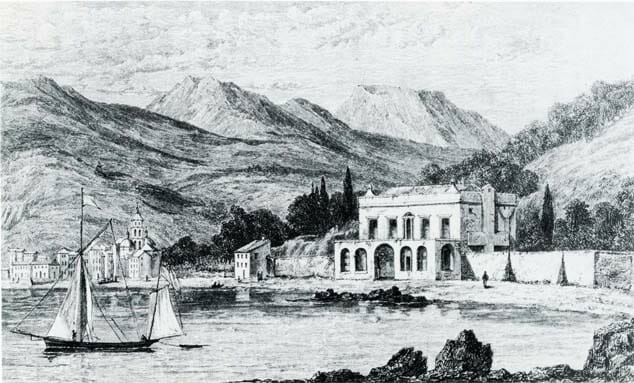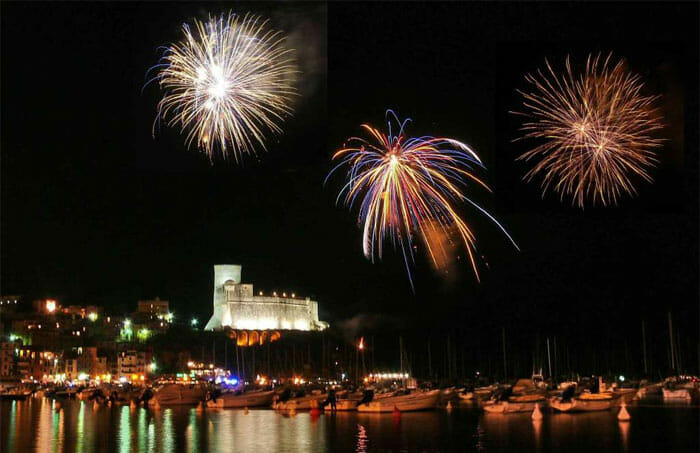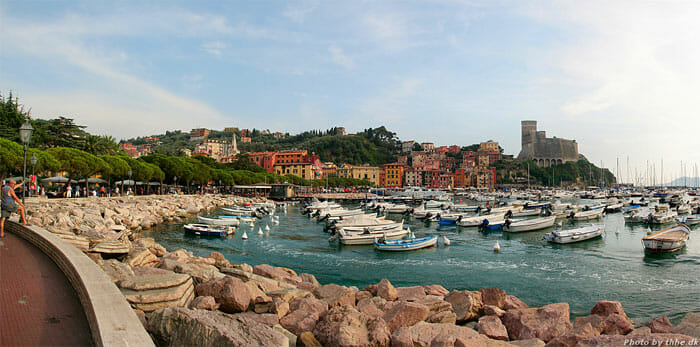On the eastern side of the Gulf of Poets, right opposite the shores of Portovenere, Le Grazie and Fezzano, sits one of the most charming villages in Liguria – and Italy.
The town’s origins date back to the Etruscan period, probably after the foundation of the future Roman town of Luni. It became an important economic and strategic center under the Republic of Genoa.
The town is nestled in a natural bay featuring a promontory, on top of which is the majestic castle. Located within the Regional Nature Park of Montemarcello-Magra, the municipal territory of Lerici includes different smaller villages, among which Tellaro, San Terenzo, Venere Azzurra and Fiascherino.
Apart from its amazing location and landscapes, what makes Lerici so special? Let’s find out!
The Shelley Myth
Lerici’s grace is such that poets like Mary Shelley and Percy Bysshe Shelley chose it as their home in the early 1800s. They lived in the whitewashed Villa Magni: at the time, its characteristic colonnade was built right on the sea, while the steep slopes of the Marigola Promontory protected it on the opposite side. Surrounding the villa was a romantic and peaceful park with beautiful walnut trees and holm oaks. “More a boat than a house” is how anthropologist Paolo Mantegazza – another famous person who chose Lerici as his home – described the house.

Percy Shelley used to sail on his boat called Don Juan (a homage to his friend Lord Byron, who lived nearby in Portovenere) along the Bay of La Spezia and down to Tuscany. On 8 July 1822, just days before turning 30 years old, Shelley drowned in a sudden storm on the Gulf of Spezia while returning from Leghorn (Livorno) to Lerici in his boat. Some believe that he was murdered due to political reasons, for this unconventional life and uncompromising idealism.
Many artists were attracted by the myth of the Shelley’s and visited or stayed in Lerici for a while, including Virginia Woolf, Gabriele d’Annunzio, Sem Benelli and Henry James. This flow of writers is what led the Bay of La Spezia to also be called Gulf of Poets.
If you would like to visit Villa Magni and be inspired by its history and beauty, it is located in the fraction of San Terenzo di Lerici. It dates back to the XVI century, when it was a convent for the Barnabite priests.
Military Architecture and Underwater Archaeology
The first thing that stands out when you reach Lerici is its imposing castle, known as Castello di Lerici or Castello di San Giorgio. It has looked this way since 1555, although the building of the fortification began in 1152.
Here is an aerial view of the castle from a drone!
https://www.youtube.com/watch?v=_2nh6eZr6oM
This wonderful castle is not only the historical symbol of the village, but it’s also a museum that periodically hosts important exhibitions.
Lerici also features an interesting underwater archeological site: beneath the waters of La Caletta cove (between Lerici and Tellaro), you can admire the remains of a Roman ship dating back to the first century BC. The ship sunk while transporting marble and you can even see a portion of a massive marble column among the ruins. The other part of the column is preserved at the Archaeological Museum in Luni.
Local gastronomic specialty & foodie events
One of the typical local dishes is the Zuppa di Datteri alla Lericina (Lerici-style date mussel soup). The date mussels come from the rocky seabed of the Bay of La Spezia, and from the mussel farms that have been created in local waters to protect the species. The soup also includes peeled tomatoes, half an onion fried in olive oil, a glass of white wine and crostini (small slices of toasted bread).
Local food festivals include the Snail Festival in La Serra di Lerici (usually in August), the Octopus Festival in Tellaro (usually in August), and the Mytiliade Mussel Festival in Lerici (usually in September).
Traditional and cultural events
The Festival of Sant’Erasmo, patron of sailors, takes place on the first Saturday of every July, involving a beautiful procession at night. The statue of the saint is first carried along the candle-lit streets of Lerici. Then, it is taken on a ship and – escorted by decorated boats – it is carried to Tellaro and San Terenzo. At the end of the solemn procession, amazing fireworks celebrate the patron saint.

Another evocative religious event is called Underwater Christmas. On Christmas Eve, the streets and the cliffs surrounding the ancient Church of San Giorgio are decorated with thousands of candles. A group of divers takes the statue of Baby Jesus from the sea and brings him ashore, handing him to the priest. The locals cheer and chant. This is followed by a procession to take the statute into the Church, where the Christmas Mass takes place.
Honoring its literary legacy, Lerici hosts a number of artistic and cultural events. Among the most important ones:
- Premio LericiPea: a poetry awards’ ceremony that takes place since 1954
- Premio Castello di Lerici: it awards the best literary-scientific book of the year
- Golfo dei Poeti Film Festival
- Tellaro Film Festival
- Una voce poco fa: it pays tribute to cinema figures who have passed away
- Lerici legge il mare: a fair about sea-related literature and culture
- Premio Lerici città di pace e di poesia: it awards poets who distinguish themselves for their work towards peace
Guided visits to Lerici and Tellaro, Gulf of Poets
If you would like to explore the beautiful Gulf of Poets and its main attractions, the boutique Grand Hotel Portovenere offers a package including guided visits in Lerici, Tellaro, Portovenere and Palmaria Island. You can also choose to visit the nearby Cinque Terre. Find out more.

4 Comments